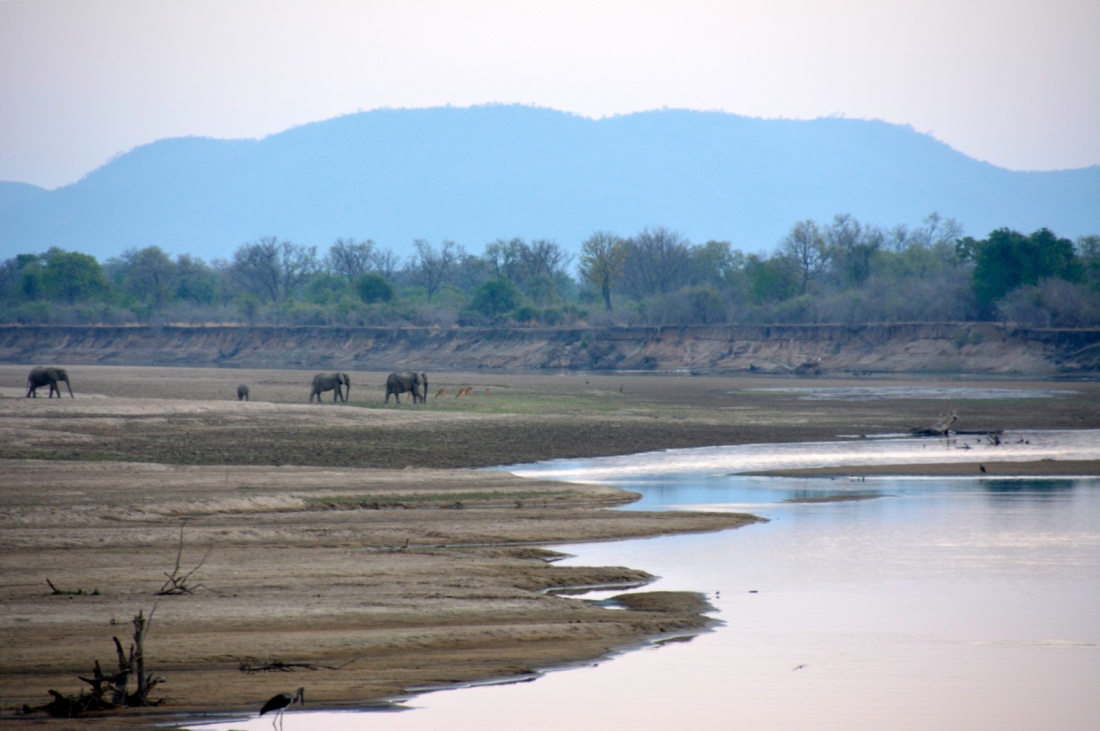
© Andrew Brown/2017/Zambia
As the sun set behind the trees of the bank of the Luangwa River in Zambia, a line of elephants began crossing the mostly parched riverbed, their distinctive trunked shapes visible in the far distance beneath blue outlined hills. In the foreground, twisted branches cast twisted reflections in the remaining water – barely a trickle compared to its rainy season extent. A hippo lifted his head out of the water and bellowed at the setting sun. I stood on a high bank above this scene, with an old-fashioned Land Rover parked behind me and a cold local Zambian beer in my hand. It was a classic African scene and an adventure I’d dreamed of since reading tales of the continent as a teenager.
South Luangwa national park is probably the best safari I’ve visited in southern Africa, yet is much less known than those in South Africa, Kenya and Tanzania. I’d lived a few hours away, just across the border in Malawi, for almost a year but had not yet visited, mainly because my two year old son, Zefi, doesn’t like long car journeys. Zefi is also a bit young for a safari. I also know form our local wildlife sanctuary that while a baboon will hold his attention for a few minutes, he’s just as likely to be interested in a stick or leaf he found on the ground.
However, we’re now expecting a second child, so Zefi and my wife Joyce are in Hong Kong for a few months while I stay in Malawi to work. Home alone, I took the chance to travel to Zambia with my friend Charlie, recently arrived in Malawi from Indonesia.
Charlie and I left Lilongwe around 1pm on the Friday, which felt like plenty of time, but we got held at the border. Long columns of trucks were waiting on the Zambian side, with clouds of black smoke billowing out of their exhaust pipes. Immigration took place reasonably efficiently in two small cabins on each side of the border, but it took our local taxi driver, Martin, much longer to process all the paperwork for his car, including buying temporary Zambian car insurance.
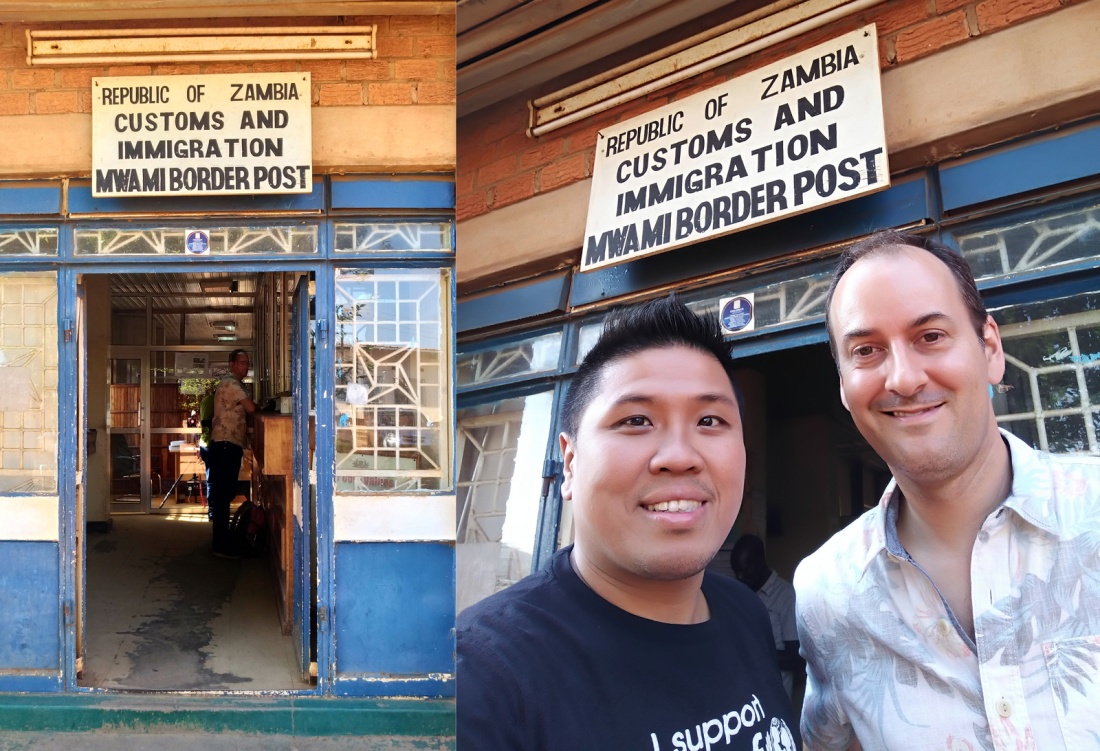
© Charlie Hartono Lie/2017/Zambia
In colonial times, Malawi, Zambia and Zimbabwe used to be part of the same country, called Rhodesia and Nyasaland, and the similarities were obvious. In villages, we saw the same mud brick houses. Small stores on the Zambian side looked identical to those in Malawi, often painted red and white in the colours of the mobile phone company AirTel, and named after Biblical verses such as Only God Knows Business Centre or Seek and Ye Shall Find Bar.
However, the differences were equally telling. Hills that on the Malawian side would have been deforested for charcoal, were still forested in Zambia and the level of development was noticeably higher. The mud brick buildings were interspersed with more modern houses and schools and, as Martin pointed out, there were many road signs along the un-potholed tarmac roads. “If they put signs like that up in Malawi, someone would steal them for the metal,” he said.
We had hoped to get to the park before dark, but because of the delays at the border it was past 6pm when we arrived at the gate, to find it closed. There were still two national park officials in a cabin by the gate, but it took us a while to persuade them to let us in. I was unsure if they were holding out for a bribe, as is all too often the case in this part of the world. Eventually they relented and let us through, after writing all our details down. Charlie’s attempts to charm them probably helped. From me, “I like your uniform” would have sounded hopelessly sarcastic, but Charlie just about pulled it off.
A few kilometres inside the park, we arrived at Mfuwe Lodge. With no fences, the animals were free to wander through the site and we had to be accompanied to our cabins after dark. It was very luxurious – the kind of accommodation I would have avoided in my backpacker days, and indeed there were some budget campsites and dorms outside the gates. But Mfuwe, for all its steep price tag, was spectacular. It sat on a bank between two rivers, with the restaurant and swimming pool perched high above the floor of the deeper valley. The pool had submerged bar stools at the edge overlooking the valley, from which you could watch elephants, zebra and impala filing along the river bed.
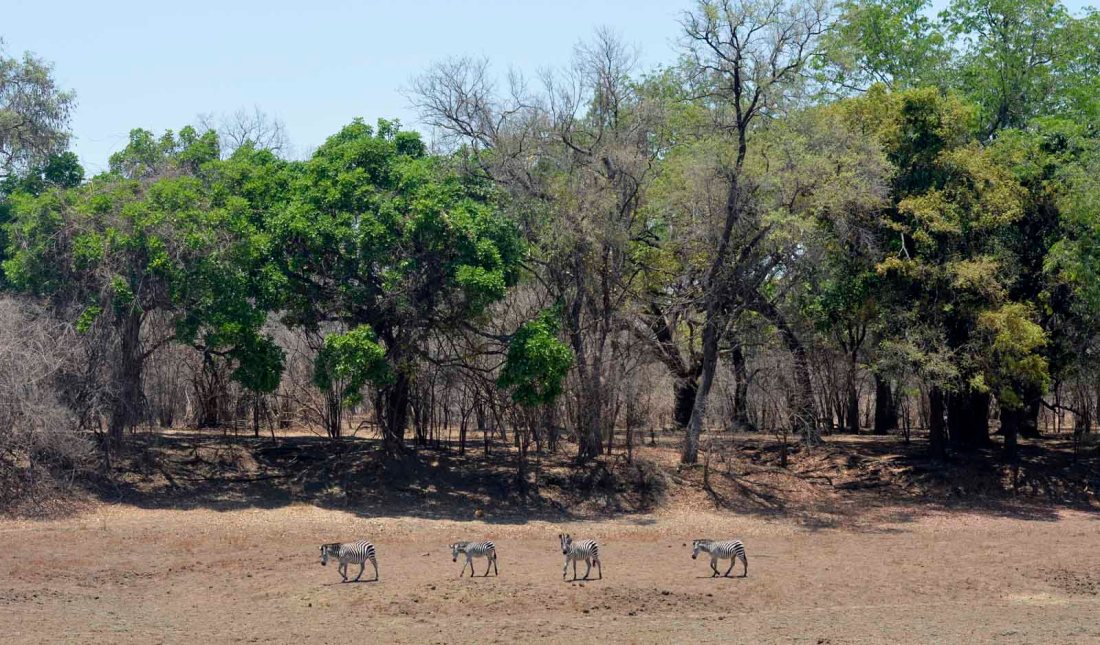
© Andrew Brown/2017/Zambia
There were a few inconveniences to being in the middle of so much nature. During the first night, I was regularly woken by the bellowing of hippos. In the morning, I opened my balcony doors to find a dozen of the animals wallowing in the mud, just metres from my room. I noticed the head of a crocodile break the surface and glide sneakily past. On the opposite bank, impala and monkeys moved through the trees, coming down to the river to drink cautiously, while keeping a close eye on the crocodiles. It was quite a sight to wake up to, and made the nightly noises worthwhile.
Over the course of the weekend, we did three game drives and one walking safari. The amount of wildlife we saw was staggering, more than I had seen on any previous safari. On our drives, we joined a local Zambian-Indian family. The children were fourth generation, their great-grandparents having arrived in Africa during the British colonial era. The driver of our Land Rover, Gilbert, was also our guide and was highly knowledgeable about the animals and environment, having come from a village just outside the park and worked in it for 25 years.
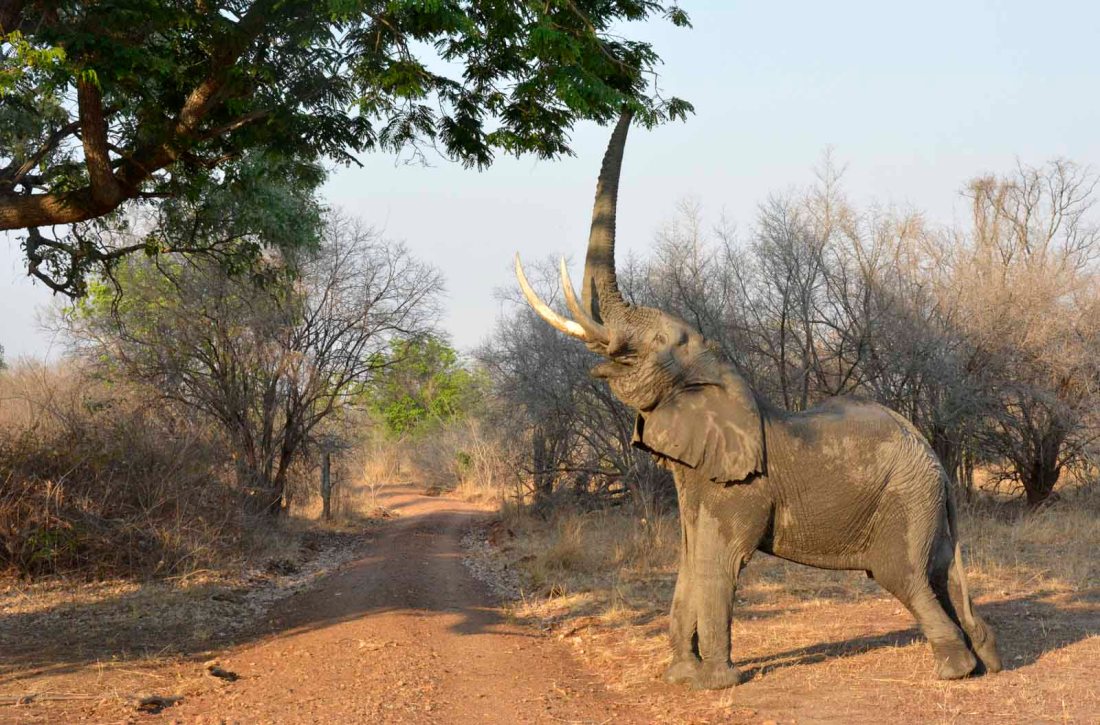
© Andrew Brown/2017/Zambia
The first animal we saw on our drive was an elephant. It stood beside the road, pulling branches and wild mangos off a tree with its trunk. When it had a branch on the ground, it stripped off the bark and ate it. Once in a while, it made a deep rumbling noise, a form of communication that allows elephants to communicate with other members of their herd over a staggering 300 square km. Our elephant was left handed, shown by the fact that its left tusk was shorter and more worn from greater use.
The elephant’s trunk is an amazing piece of evolution, considering that it started out as a regular nose. “There are more than 2,000 muscles in an elephant’s trunk,” Gilbert explained. “It has three pipes, so the elephant can suck and hold water in the middle pipe, while still breathing through the other two. It’s also their main weapon – they can kill with a single blow from it. Sometimes a pride of lions will attack a small elephant. They will begin with eight lions immobilizing its truck, then the others make the kill.”

© Andrew Brown/2017/Zambia
Next to the elephant were a pack of wild dogs, looking much like their domestic cousins except for their large round ears. Of course, their behaviour is very different and we were lucky to see them – these are among the rarest animals in the park. We passed a herd of buffalo, with one large male squaring off against our antique Land Rover in a show of strength. And we saw lots of impala, an African deer which is often overlooked because it’s small, commonplace and not dangerous. In fact, they are beautiful animals, with long narrow faces, large black eyes, and horns that curve out and twist elegantly back in.
We saw a male impala chasing a female, but she was faster than him and got away. “Most of the females are pregnant at this time of year,” Gilbert said. “But there are still a few like this one that are not. Usually the alpha male mates with them, but sometimes he gets tired and other males take over and try their luck.”

© Andrew Brown/2017/Zambia
We continued through a dry, sparse landscape of low bushes and bare stick trees, with the occasional large baobab spreading its branches wide and providing some welcome shade. Outside the park, in Zambia as in Malawi, villages are often built around a baobab tree, with the space under the tree providing a communal space for village meetings and storytelling (hence the name of this blog). The sky was clear, with flocks of small birds moved in unison and apparently at random.
Part of the reason that we saw so many animals was that with limited water, they were forced to come out into the open. We were visiting right at the end of the dry season, and the first tentative rains had fallen overnight. New green leaves sprouted amongst the dry bush in places where the water had pooled. “In a few days, all of this will be green,” Gilbert said, gesturing at the still mostly parched landscape.
There was a sudden shock of white amidst the yellow and brown. We stopped by a large hippo skeleton, and I got out of the Land Rover for a closer look. Its skull seemed a little too perfectly posed at the end of a long curved spine, as if it had just sat down for moment to watch us through its empty eye sockets. I asked Gilbert about this. “The hippo was killed by lions last year,” Gilbert explained. “Sometimes hyenas drag the bones away, but people put them back in place.”

© Andrew Brown/2017/Zambia
Next we encountered three giraffe – two female and one male. Giraffes are beautiful animals but not very practical. Their heads nodded at the end of their long necks as they walked, as if they were trying to keep balance and avoid toppling over. Giraffes cannot lie down and have to spread their front legs and lower their neck to drink. According to Gilbert, they’re related to camels (this is true but the relationship is very distant), another oddity of nature. Of course, the giraffe’s neck allows it to browse the high leaves that no other animals can reach, just as the camel’s hump enables it to store water and survive in the arid dessert.
As with the impala we saw earlier, the male giraffe was trying to mate with one of the females. He pursued her slowly and laboriously, trying to prevent her from joining the other female. But she kept moving ahead of him, just out of his reach.
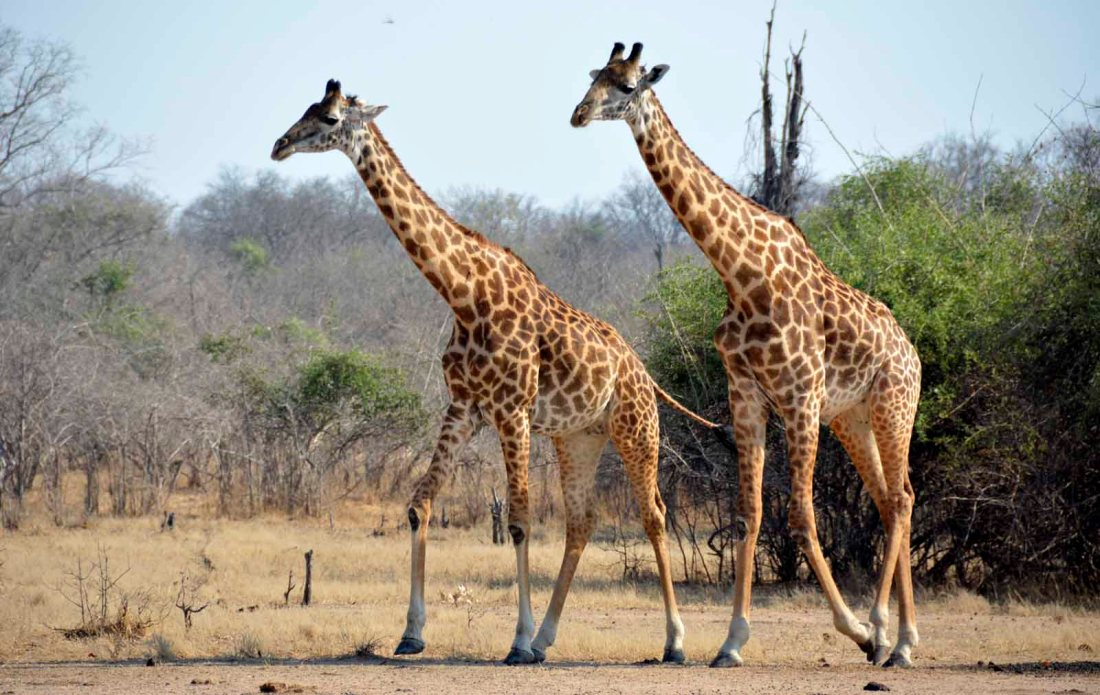
© Andrew Brown/2017/Zambia
We stopped for a break by a tree with a good stretch of clear ground on all sides. With no cover for predators, it was safe to get out of the Land Rover for a very British break of tea and biscuits. It felt good to stretch our legs and to be on foot in the environment, rather than sitting above it. But just as we were finishing our tea, we heard a crashing noise from the trees opposite us and three elephants appeared, making straight for us. “Get back in the vehicle,” Gilbert advised with a note of urgency in his voice.
He started clapping loudly and regularly. Afterwards, I asked why. “The elephant’s eyesight is very bad,” he explained. “It relies on sound and smell. I clapped to let the matriarch know that we’re here. She was after the seed pods in the tree. Now that she knows this tree is taken, she will chose another one.” Sure enough, the elephant changed course and made for another similar tree across a dried out river bed. The two smaller elephants followed.
It was the only time I saw Gilbert alarmed. “You have to respect the elephant,” he said. “An adult elephant weighs six tonnes and can charge at 70 km per hour. It knows it is powerful and that nothing can stop it. It can easily flip a Land Rover and tusk the people inside. In my village, we lose five or six people a year to elephants. If I was caught between an elephant and a lion, I would go towards the lion.”
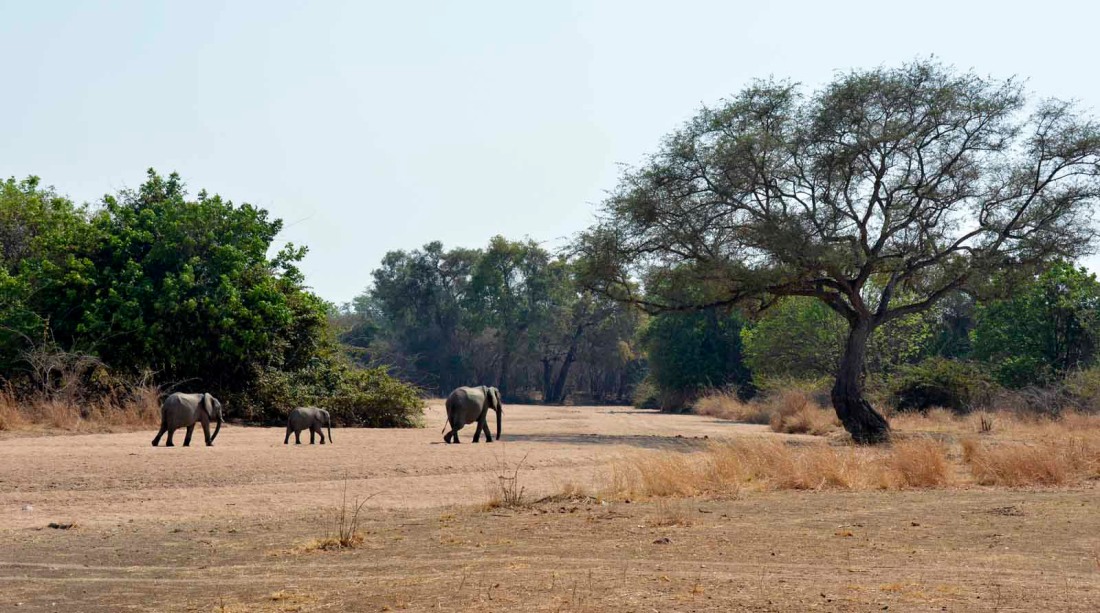
© Andrew Brown/2017/Zambia
The last animal we saw on this drive was a leopard. Gilbert spotted it sleeping in a tree and we pulled up for a closer look. It was fast asleep on a branch, with two legs hanging down on either side to keep it in place. Its chest was rising and falling as it breathed deeply but much faster than a human would. From below, the leopard’s spots provide camouflage.
The leopard’s choice of tree was significant – it had flowers that impala like to eat. “When the impala come, the leopard will move to a lower branch, and drop onto the back of a female,” Gilbert said. “I have seen it happen. Usually the leopard hunts at night, but if the impala come during the day, it will try to take one.”
We returned to our lodge around 11am for brunch. It was already getting uncomfortably hot and I planned to spend the next few hours in the pool or editing photos in the shade. In the second part of this post, I’ll tell you about the walking and night safaris.
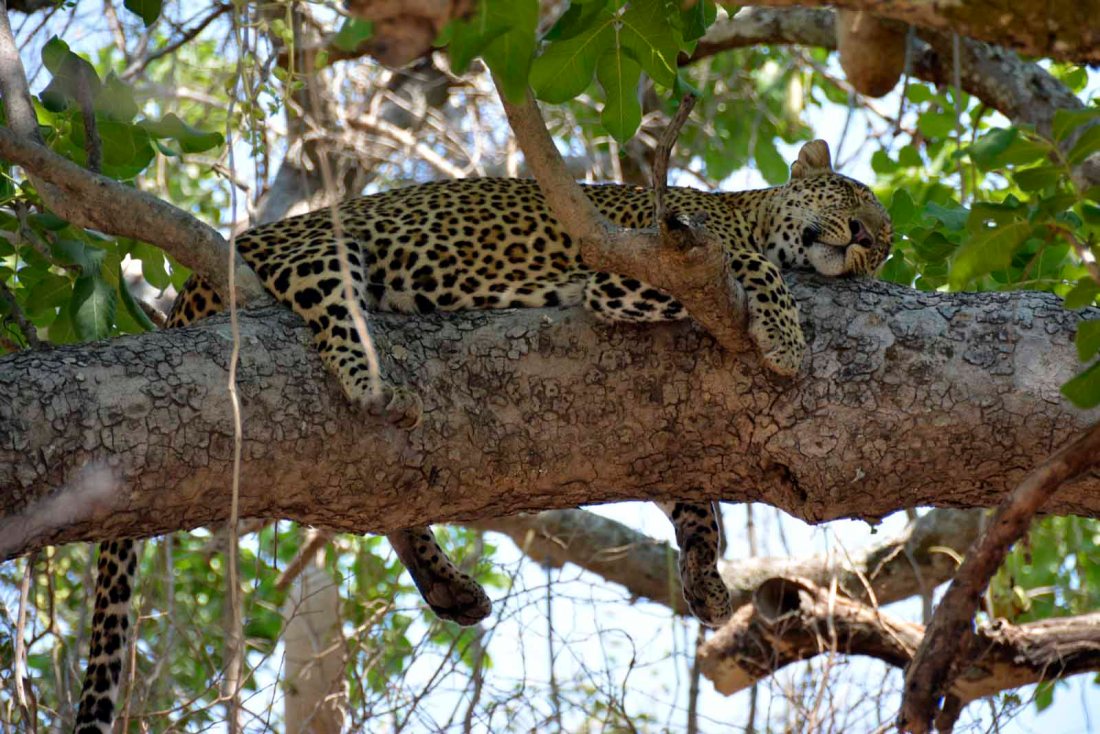
© Andrew Brown/2017/Zambia
Nice read!
LikeLiked by 1 person
Great read! Time to start throwing coins into the piggy bank for this trip.
LikeLiked by 1 person